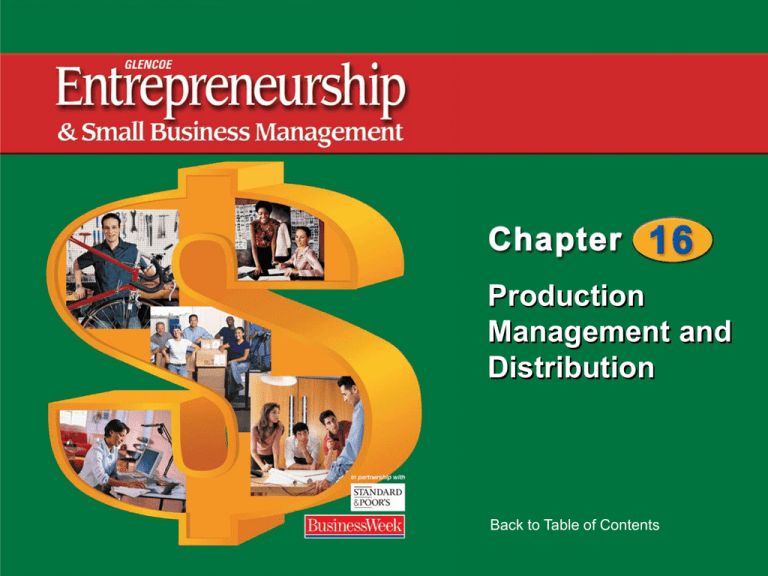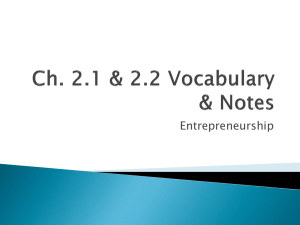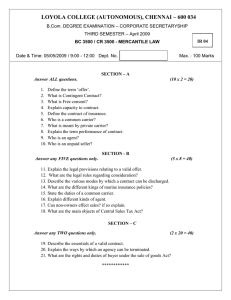Production Management and Distribution Back to Table of Contents
advertisement

Production Management and Distribution Back to Table of Contents Chapter 16 Production Management and Distribution Production Management and Distribution 16.1 From Idea to Product 16.2 Production and Distribution 2 Production Management and Distribution 16.1 Discuss how entrepreneurs develop new products. Explain the product development process. Section 16.1 From Idea to Product 3 Production Management and Distribution 16.1 Entrepreneurs work with limited resources, so they must find creative ways to develop and manufacture their products, such as outsourcing. Product development is a repetitive process based on feedback from customers who test the product. Section 16.1 From Idea to Product 4 Production Management and Distribution 16.1 product development outsourcing prototype Section 16.1 From Idea to Product 5 Production Management and Distribution Product Development for Entrepreneurs The transformation from idea to marketable product is a lengthy process. Entrepreneurs must learn how to develop new products with limited resources. Section 16.1 From Idea to Product 6 Production Management and Distribution What Is Product Development? Some people consider product development to be the riskiest part of start-up of a new small business. Section 16.1 From Idea to Product product development the process of creating new or improved products, involving taking an idea for a product, designing it, building a model, and testing it 7 Production Management and Distribution Outsourcing Product Development No matter what they are producing, entrepreneurs can use outsourcing to reduce the cost of product development. Section 16.1 From Idea to Product outsourcing hiring people and other companies to handle tasks a business can not do or chooses not to do itself 8 Production Management and Distribution The Product Development Process The four steps of product development are: 1. 2. 3. 4. opportunity recognition concept investigation product design prototype building and testing Section 16.1 From Idea to Product 9 Production Management and Distribution The Product Development Process Product development is not a linear process. An entrepreneur may start developing a product and along the way discover something new that changes the direction of development. Section 16.1 From Idea to Product 10 Production Management and Distribution The Product Development Process A prototype may not look like the final product, but should work like the final product. Section 16.1 From Idea to Product prototype a working model of a product 11 Production Management and Distribution Designing It Right the First Time There are three good reasons for designing a product right the first time: 1. the cost of the design 2. the quality and marketability of the product 3. the time to launch Section 16.1 From Idea to Product 12 Production Management and Distribution 16.1 1. Discuss how entrepreneurs develop new products. Once entrepreneurs recognize an opportunity for a product, they study the market to make certain there is sufficient demand. They design the product on paper or on a computer, incorporating the needs and wants of potential customers and including input from the people involved in marketing, producing, and financing the product. They build a prototype to test the product with customers. Section 16.1 From Idea to Product 13 Production Management and Distribution 16.1 2. Explain the product development process. Product development is not a linear process. Although it appears to move forward in a step-by-step manner, it is really a repetitive process. An entrepreneur may start developing a product and along the way discover something new that changes the direction of development. Section 16.1 From Idea to Product 14 Production Management and Distribution 16.2 Explain what is involved in production management. Describe the activities that are part of distribution management. Section 16.2 Production and Distribution 15 Production Management and Distribution 16.2 Coming up with an idea for a product or service is only a small part of creating a successful business—you have to turn that idea into reality. Production and distribution are two ways entrepreneurs bring new products to market. Section 16.2 Production and Distribution 16 Production Management and Distribution 16.2 Gantt chart PERT diagram quality control quality circle productivity automation Section 16.2 Production and Distribution logistics common carrier contract carrier private carrier freight on board (FOB) 17 Production Management and Distribution Production Management Once you have developed a prototype, you are ready to plan production. Section 16.2 Production and Distribution 18 Production Management and Distribution Production Management Production management involves three functions: 1. Acquiring the resources needed to create a product. 2. Planning how to convert those resources into products. 3. Making sure the products meet the standards set for them. Section 16.2 Production and Distribution 19 Production Management Scheduling Maintenance Areas of Production Management Automation Section 16.2 Production and Distribution Quality Control Productivity 20 Production Management and Distribution Scheduling Businesses plan their production by making schedules. These schedules describe each activity that must be completed to produce goods or services. Section 16.2 Production and Distribution 21 Production Management and Distribution Scheduling A Gantt chart is an effective way to depict basic information about a project. Section 16.2 Production and Distribution Gannt chart a graphic schedule of a project’s phases, activities, and tasks plotted against a time line 22 Production Management and Distribution Scheduling The longest path through a PERT diagram, the critical path, dictates the length of time needed to complete a project. Section 16.2 Production and Distribution PERT diagram a project schedule that is arranged in a diagram used for scheduling complex projects 23 Production Management and Distribution Controlling Quality Quality control takes time and costs money, but it is a way to ensure customer satisfaction. Section 16.2 Production and Distribution quality control the process of making sure the goods or services a business produces meet certain standards, such as appearance, performance, and consistency 24 Production Management and Distribution Controlling Quality A quality circle is an effective way of improving quality because it requires employees to be responsible for their work. Section 16.2 Production and Distribution quality circle a small group of employees who do similar jobs and meet regularly to identify ways to improve the quality of what they do 25 Production Management and Distribution Managing Other Areas of Production Businesses use productivity rates to measure and improve performance. productivity a measure of how much a business produces in a given time, or the output of each worker per unit of time Automation can cut production time, reduce errors, and simplify procedures. automation the use of machines to do the work of people Section 16.2 Production and Distribution 26 Production Management and Distribution Distribution Management Distribution management includes: transportation shipping and receiving storage and warehousing materials handling delivery terms Section 16.2 Production and Distribution 27 Production Management and Distribution Transportation Logistics involves figuring out how to move a product from the producer to the customer. Section 16.2 Production and Distribution logistics the planning, execution, and control of the movement and placement of people and/or goods 28 Production Management and Distribution Transportation A common carrier is hired by businesses to transport products. Section 16.2 Production and Distribution common carrier a firm that provides transportation services at uniform rates to the general public 29 Production Management and Distribution Transportation A railroad is a contract carrier. Section 16.2 Production and Distribution contract carrier a shipping company that transports freight under contract with one or more shippers 30 Production Management and Distribution Transportation A private carrier is a privately owned and operated delivery vehicle. Section 16.2 Production and Distribution private carrier a business that operates vehicles primarily for the purpose of transporting its own products and materials 31 Production Management and Distribution Delivery Terms The most favorable delivery term for a small business is free on board (FOB). Section 16.2 Production and Distribution free on board (FOB) a delivery term that designates a shipment as delivered for no additional charge to a buyer 32 Production Management and Distribution 16.2 1. Explain what is involved in production management. Production management has three functions: acquiring the resources needed to create a product, planning how to convert those resources into products, and making sure the products meet set standards. Section 16.2 Production and Distribution 33 Production Management and Distribution 16.2 2. Describe the activities that are part of distribution management. Distribution management includes transportation, shipping and receiving, storage and warehousing, materials handling, and specification of delivery terms. It controls the movement of a product from the manufacturer to customers. Section 16.2 Production and Distribution 34 Production Management and Distribution Distribution in E-Commerce In e-commerce, as in other types of businesses, one of the most important functions is delivering the right product or service in the right place at the right time. E-commerce channels, intermediaries, and cybermediaries are all vital parts of electronic distribution. Section 16.2 Production and Distribution 35 Production Management and Distribution Tech Terms cybermediary a business that acts as a broker or agent to facilitate transactions over the Internet disintermediation the removal of intermediaries, such as wholesalers or retailers, from business transactions between producers and consumers Section 16.2 Production and Distribution 36 Production Management and Distribution Tech Terms intermediary a business that is involved in the process of moving a product from the manufacturer to a customer or user Web affiliate a company that aims to drive targeted traffic to a Web site, usually an e-commerce merchant, usually for a commission for the sales they generate on the merchant site Section 16.2 Production and Distribution 37 End of Production Management and Distribution Back to Table of Contents



